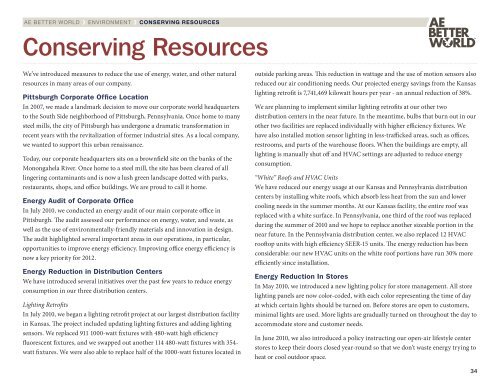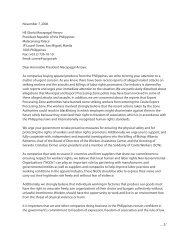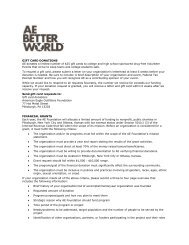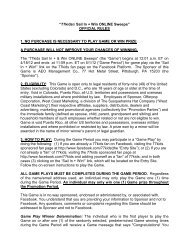Download PDF Version - American Eagle Outfitters
Download PDF Version - American Eagle Outfitters
Download PDF Version - American Eagle Outfitters
Create successful ePaper yourself
Turn your PDF publications into a flip-book with our unique Google optimized e-Paper software.
AE BETTER WORLD ENVIRONMENT CONSERVING RESOURCES<br />
Conserving Resources outside parking areas. This reduction in wattage and the use of motion sensors also<br />
We’ve introduced measures to reduce the use of energy, water, and other natural<br />
resources in many areas of our company.<br />
Pittsburgh Corporate Office Location<br />
In 2007, we made a landmark decision to move our corporate world headquarters<br />
to the South Side neighborhood of Pittsburgh, Pennsylvania. Once home to many<br />
steel mills, the city of Pittsburgh has undergone a dramatic transformation in<br />
recent years with the revitalization of former industrial sites. As a local company,<br />
we wanted to support this urban renaissance.<br />
Today, our corporate headquarters sits on a brownfield site on the banks of the<br />
Monongahela River. Once home to a steel mill, the site has been cleared of all<br />
lingering contaminants and is now a lush green landscape dotted with parks,<br />
restaurants, shops, and office buildings. We are proud to call it home.<br />
Energy Audit of Corporate Office<br />
In July 2010, we conducted an energy audit of our main corporate office in<br />
Pittsburgh. The audit assessed our performance on energy, water, and waste, as<br />
well as the use of environmentally-friendly materials and innovation in design.<br />
The audit highlighted several important areas in our operations, in particular,<br />
opportunities to improve energy efficiency. Improving office energy efficiency is<br />
now a key priority for 2012.<br />
Energy Reduction in Distribution Centers<br />
We have introduced several initiatives over the past few years to reduce energy<br />
consumption in our three distribution centers.<br />
Lighting Retrofits<br />
In July 2010, we began a lighting retrofit project at our largest distribution facility<br />
in Kansas. The project included updating lighting fixtures and adding lighting<br />
sensors. We replaced 911 1000-watt fixtures with 480-watt high efficiency<br />
fluorescent fixtures, and we swapped out another 114 480-watt fixtures with 354watt<br />
fixtures. We were also able to replace half of the 1000-watt fixtures located in<br />
reduced our air conditioning needs. Our projected energy savings from the Kansas<br />
lighting retrofit is 7,741,469 kilowatt hours per year - an annual reduction of 38%.<br />
We are planning to implement similar lighting retrofits at our other two<br />
distribution centers in the near future. In the meantime, bulbs that burn out in our<br />
other two facilities are replaced individually with higher efficiency fixtures. We<br />
have also installed motion sensor lighting in less-trafficked areas, such as offices,<br />
restrooms, and parts of the warehouse floors. When the buildings are empty, all<br />
lighting is manually shut off and HVAC settings are adjusted to reduce energy<br />
consumption.<br />
“White” Roofs and HVAC Units<br />
We have reduced our energy usage at our Kansas and Pennsylvania distribution<br />
centers by installing white roofs, which absorb less heat from the sun and lower<br />
cooling needs in the summer months. At our Kansas facility, the entire roof was<br />
replaced with a white surface. In Pennsylvania, one third of the roof was replaced<br />
during the summer of 2010 and we hope to replace another sizeable portion in the<br />
near future. In the Pennsylvania distribution center, we also replaced 12 HVAC<br />
rooftop units with high efficiency SEER-15 units. The energy reduction has been<br />
considerable: our new HVAC units on the white roof portions have run 30% more<br />
efficiently since installation.<br />
Energy Reduction In Stores<br />
In May 2010, we introduced a new lighting policy for store management. All store<br />
lighting panels are now color-coded, with each color representing the time of day<br />
at which certain lights should be turned on. Before stores are open to customers,<br />
minimal lights are used. More lights are gradually turned on throughout the day to<br />
accommodate store and customer needs.<br />
In June 2010, we also introduced a policy instructing our open-air lifestyle center<br />
stores to keep their doors closed year-round so that we don’t waste energy trying to<br />
heat or cool outdoor space.<br />
34






